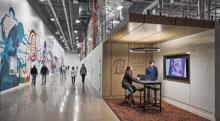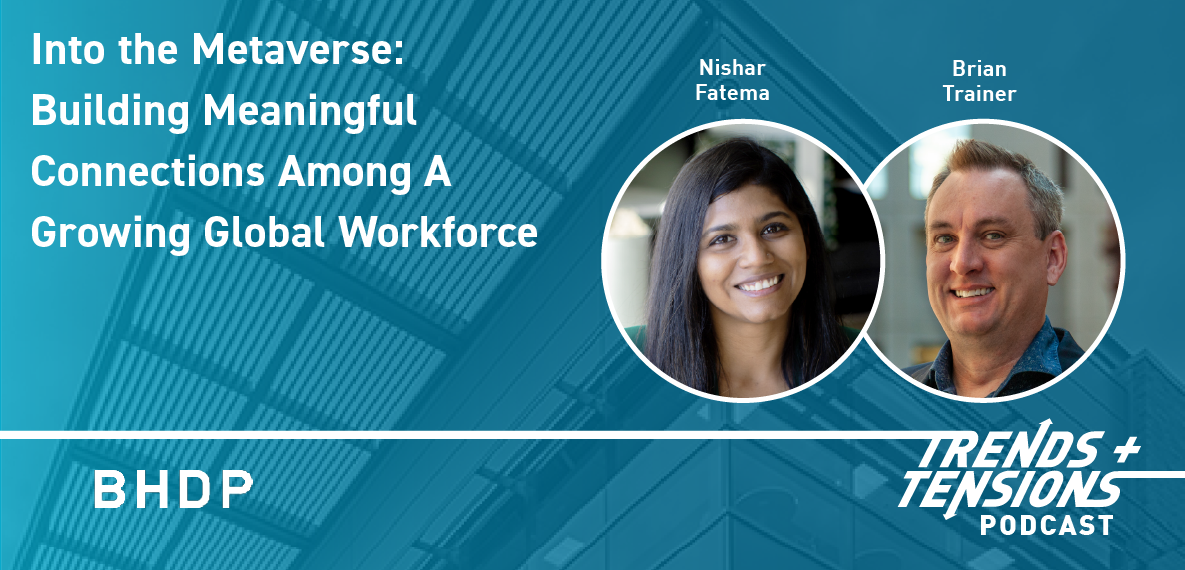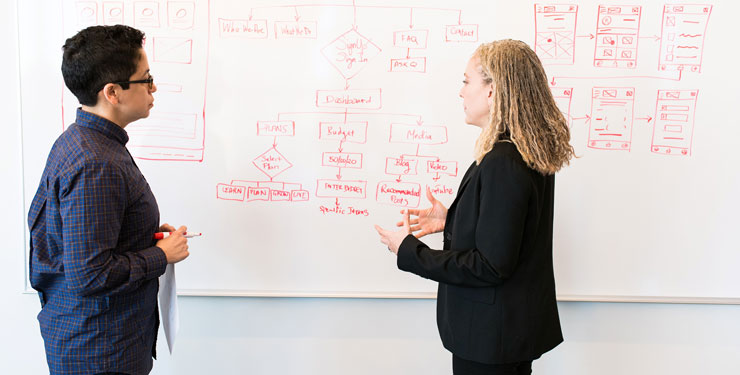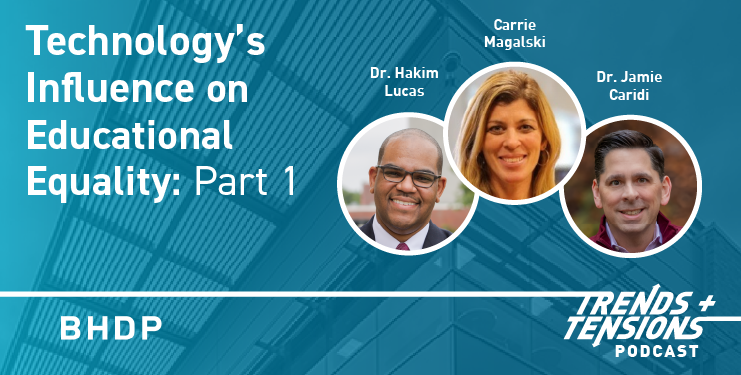
Into the Metaverse: Building Meaningful Connections Among A Growing Global Workforce

Want to listen on another platform? Choose your platform here.
Episode Transcript
[Music Intro]
Brian Trainer, Host:
Brian: Tell us about yourself, Nishar.
Nishar Fatema: Yeah. Firstly, I'm extremely humbled to have this opportunity to speak with you, Brian, and such an amazing platform and a topic you guys have put together for Trends + Tensions. Right, so thank you so much for having me. My name is Nishar Fatima; I lead the global workplace strategy efforts for ServiceNow. And my main goal or focus under this role is to maximize Employee Engagement. Especially, I would say, by leveraging the power of technology, artificial intelligence---ServiceNow being a cutting-edge technology company---but specifically focusing on how to improve performances of our services processes and real estate portfolio. I would say in addition to that, I also lead our workplace strategy initiatives, which are mainly focused on, I would say, more data intelligence side, which is predominantly driven by an evidence-based approach, right? So explore tools, which will help enhance our employee experiences, and one of the projects obviously is eetaverse, which is very dear to my heart. I'm super excited to be here and speaking with you today.
Brian: We're excited, too. I think Lucy, our producer, and I have been talking about this one a lot. So where did this journey into the metaverse begin for you? And what problems were you trying to solve?
Nishar: So, I want to start by saying that there couldn't be a better time to be in the world of tech in the history of our generation.
Brian: Yeah.
Nishar: I feel there is not only the highest level of opportunities right now but the increased level of flexibility in the way we work today. And that kind of brings my focus into the workplace strategy role as I lead our world of work initiatives, which really means, in many other words, is future of work, right? And it's mainly to bring our cultural alignment between our 78 global locations and especially myself; I have been lucky to have the opportunity to work in various countries and live in different cultures, like Germany, Singapore, Iran, India, and now in New York. It really helps me to bring that global perspective onto the table, and for today's discussion, my perspective is more going to be coming out from the occupier’s lens. I'm going to take a step back a little bit and help you understand the overall scenario of where the conversation of metaverse began at our organization. For the audience who are listening, I think we can't deny the fact that it's an expensive undertaking, right?
Brian: Yes.
Nishar: So the question is, is it worth the investment? That's really the dilemma and the conversation we started at ServiceNow. We could start by asking why you are doing it instead of asking what you are doing.
Brian: Okay.
Nishar: And that will really get you to your root cause of why you want to implement metaverse. Not because “it's just a cool technology everybody's exploring, so let's ride the bandwagon,” that's really not how we started with.
[Brian laughs]
Nishar: It was really questioning ourselves; why do we want to explore this, right? And to answer your second question more on what problems we are trying to solve, for the feedback which we receive from our employees through the Pulse Survey Focus Group and Global Listening Tours. All of that had a common factor, and they were mostly focusing on the lack of informal collaboration and what we call water cooler chats in the work environment. And also, about building that interpersonal connection was really, really important for our employees, which came up in many conversations. And then, last but not least, is a sense of community was missing. So, all these aspects sort of tied together as feedback which really helped us dig deeper into the metaverse.
Brian: It's interesting because that topic has come up a lot. How do we get this sense of community back, understanding that the landscape has changed? People do want that work-life flexibility of working remotely. Can you describe the virtual environment? How do people engage with the space and with each other?
Nishar: About one-third of our company is a remote persona, and remote personas are those who are not coming into the office on a daily basis, right? They are only coming to the office for moments that matter. So what happened was, having said that, the need for better connectivity between that remote person and flexibility became really, really all the more important, right? Giving the best experiences to do with employee engagement and increasing collaboration became extremely critical between those personas. So, between remote workers and flexible workers, now you know, we are at this crossroads where we were questioning how do we bridge that gap. And my suggestion would be that your conversation should start by shifting from the ROI aspect, which is your return on investment, to return on human capital in many ways, right? And tie it back to employee experience and engagement because that's one of the biggest challenges today every organization is facing, right? How do we really give our employees the best experience in engagement, whether they are working remotely in a hybrid situation or even if they're coming into the office, and that's where the concept of metaverse came into existence for us.
Brian: So, it was a need to increase that human experience and keep people engaged. Not just with the company culture but with each other.
Nishar: Absolutely.
Brian: Perfect.
Nishar: Yeah, and what happened was also, the legacy tools like Zoom, Teams, they don’t give you life-like experience. I can see you, but torso and above, and it's like a TV screen, and I see a news reader on the screen, right? So, it doesn't give me that interaction in the real-life kind of environment feeling. And when we explored metaverse---I'll share a little personal story about myself. So, I'm a pandemic hire to ServiceNow as well, and really, for almost one year, I did not get to meet my colleagues in person. When we did our first pilot with metaverse, with Oculus, and everything, we had a little moments that matter situation where we were all in the virtual world. We were burning marshmallows around the fire, and after that session, I really felt like I had a moment with my colleagues, like a real-life moment with my colleagues. I felt like I met them. And once I had that realization, I tied it back to the organizational level that if I'm feeling like that, half of our company is new, their pandemic hires, and they must be feeling similar things. So, that is where we kind of tied it back and said, “Why don't I let others explore this tool as well and see if it works for us?”
Brian: That's great. You keep saying moments that matter, and it sounds like a bell in my head because it's such a delightful phrase, but it really kind of captures the purpose of bringing people together when you're talking about a distributed environment. You know, there's purpose behind that. So, did you want to talk more about the virtual environment, like how people engage in space? So, you talked about like the campfire moment with the marshmallows. I love that personal story. Were there other examples of that?
Nishar: Yeah, so I can talk about the pilot itself.
Brian: Sure!
Nishar: When we launched the pilot to bridge that gap, like I mentioned earlier, in the hybrid world, it was interesting to know that, actually, 55% of the total users were women. So, I was very happy that there was good diversity among the pilot users, to begin with, but at the same time, we explored various use cases as well, like a remote virtual office, tried and created water cooler chats and moments within the virtual environment. Then we had a cross-functional team get together. We had a speakeasy moment where we had a dance-off, and there were pretty decided moves in metaverse, so people who did not know how to dance were really feeling like, “I would never do this in real life, but I would do it in metaverse.” So, the confidence level was, really, you can see it's coming up, right?
Brian: Yeah.
Nishar: We've also played scavenger hunt in the virtual world, which was a huge hit for our employees. They really liked that scavenger hunt, of getting to know the virtual environment by playing a game and in a little bit of a competitive spirit, right? But also on the more formal side, we had a Teams meetings office hours with your manager kind of moments, as well. So, these are the use cases we ran for about two months for the pilot, and there were participants from various orgs, cross-functional orgs like people teams, technology, finance, and product marketing team. So, we wanted to make sure that it's spread across to various orgs so that we understand that this tool is not for just one kind of team, but it really works for different kinds of teams no matter what kind of org you come from.
Brian: You had spoken about---you did a diversity experiment in the metaverse, as well, with avatars. Do you mind talking about that at all?
Nishar: Yeah, absolutely. So, diversity and inclusion and specifically equitable experience, I would say, was really huge, and ServiceNow is huge on it. So, we wanted to try and test it out; how does it work in metaverse?
Brian: Sure.
Nishar: And I feel like metaverse environment has that power to allow you to step into somebody else's shoes to experience what they feel like. And I think that that was amazingly powerful, in my opinion. So, we all got together as a team into metaverse, and we exchanged our avatars. So, if I'm a brown female, I came out as maybe a white male, right, and completely experienced somebody else. If there is a blonde female, she came out as a black male to experience how they are received. And we wiped our names of our avatars so nobody knows who you actually are, so when you go and interact with people to see how you are received. And that kind of made us realize how you step in somebody else's shoes to experience the world, and I thought the outcome was super powerful. When we did a post-pilot survey of virtual occupancy, that was one of the aspects our employees actually focused on, and saying that we really felt equitable and inclusive in the virtual environment. Everybody was level-planed, basically. So that was a super powerful way of increasing that equitable and inclusive experience.
Brian: That is, it's fascinating because it's a great experiment in empathy, you know, for someone to see how it's received or what's different and how people behave. I like that post-pilot virtual occupancy.
Nishar: Actually, I also would like to add that the tool which the platform which we were using they have made huge progress in this arena, and D&I aspects like users are allowed to add suffixes or prefixes. They are also enabling the accessibility features where you have a live language translation, so if I'm speaking in Japanese, they would live translate subtitles in English so that you can interact in the virtual environment. So, it's very accessible, very inclusive, and I thought that was powerful.
Brian: No kidding! So, I want to ask out of curiosity what kind of hardware was involved. Like, if somebody's listening and we're talking about avatars, is this just on your screen, or were they wearing some sort of device?
Nishar: Great question, Brian, and I should have mentioned it actually because it was a big part of our pilot. We did not have Oculus, the glasses which you put it on your eyes; it was a screen experience, which is why I also like to use the word extended reality.
Brian: Yes.
Nishar: We did a pilot last year with Oculus, and we felt it was not super inclusive for, at least for ServiceNow. There was one colleague whose hand was fractured, and she could not hold the remote controller to operate in the metaverse. There was a colleague who was wearing spectacles, and he didn't feel comfortable to stay in Oculus for more than half an hour. So, we thought that if we want to look at this from a scalability point of view and a rollout point of view, we have to have a simpler solution. So, the version we used was a screen experience, so, just like any video games we play today, like Fortnite, but what was more interesting was that the features which were added through this platform were very lifelike. So, if you're far, you won't be able to hear me even in the virtual world. There were certain areas which were demarcated if you are stepping in that area, even out in the open, then the other people who are out of that circle won't be able to hear you. So, you are in the outer world between a lot of people, but if two people are in that circle, then they only can hear each other but can see everybody. So, there were a lot of features that were added, which I thought were amazing and lifelike.
Brian: That's pretty cool now that you've experienced the metaverse. Who designs that experience? Like how customizable is the version you were demoing?
Nishar: There are certain aspects to it, I would say. So, in my mind, the responsibility of conceptualizing obviously revolves with the end user because your need, your use cases, you only know it the best. But also, to create the world, obviously, you should take a help of design teams because they are creating the virtual 3D visualizations of your actual space, in any case, right?
Brian: Yes.
Nishar: So, you could do that and obviously have to partner with the metaverse pilot to create that feature which are available and need to enhance on the employee engagement side of the piece. If any companies are willing to go to the length of creating a digital twin of their physical offices, then I would say design partners are your best friends. And for the reason because they have already designed your physical office environment in the 3D visualization form or walkthroughs, right? If you take that model and transfer into the metaverse world, then your actual physical office has a twin in the digital world, and a metaverse partner could help make it active in the environment. So, I would say that's where the power of utilizing what you already have and creating the digital twin is. I would also like to focus on that in the digital twin environment, the advantages are, especially for ServiceNow's perspective and many other global companies, right? Our employees are from different continents and connecting with global colleagues, right, and you're not always able to travel to different locations. So, our colleagues from Singapore can come to headquarters in California in the virtual world and be able to experience our California office without spending on air tickets, reducing the carbon footprint, and doesn't have to leave the family.
Brian: Yeah!
Nishar: Right? There are a lot of advantages to that. So, those kinds of advantages we could take a look at it. We were discussing about can this be used for like new higher orientation. And if we have five locations in North America where new hires orientation takes place, maybe we could bring them all for one session in metaverse at the same location at our HQ or one of the other hub offices, right? So, there are a lot of use cases we could explore by creating the digital twin. There's one more angle to it, is if one wants to focus on the engagement aspect from the inclusivity and diversity perspective active, then I would say bring your people team into the conversation, your HR team into the conversation, because they will bring the best value of how the engagement should happen. So, these are some of the partners I would suggest that you want to keep in the loop and, of course, the digital technology and innovation team because they will help you implement it and basically roll it out to your organization.
Brian: Thank you, Nishar. Because one of the things I realize we do as architects when we're designing the space in the software we use, is it's already in three dimensions, like the bridge to take that into a digital twin should not be very difficult. I feel like that's got to exist already. And I know that as I've explored other careers for architects, some of the things I've seen people are doing game design already, and some of those environments in video games are extraordinary. It's like, do you want to experience France during the Renaissance Era? Play this game, you know? And the fact that you could have that level of experience, I mean you talk about bringing people from Singapore into the California office, that would be a very fascinating experience because one: it's very expensive to fly to Singapore, one: you've saved a lot of money, but two: just the fact that you could all be in the same room, somebody physically there and somebody virtually there and the hardware experience is minimized.
Nishar: I mean, we had so much fun, Brian, putting this together and playing in the virtual environment. It did not feel like it was part of the work even.
Brian: Yeah
Nishar: So, which is why a lot of our colleagues were like, can we roll this out right away? But at the same time, we want to be sensible in terms of like it's not a, like I mentioned, right, it's not a cheaper solution. So, how can we bring the best value, and what are the use cases we want to explore because there are a ton.
Brian: Sure, absolutely. Well, then, you know, you said you had a lot of fun with it. If you were going to do another pilot, what would you do differently?
Nishar: So, I definitely have a lot of lessons learned from the pilot itself, but kind of two of them were the highlights when I did a postpartum analysis.
[Laughing]
Brian: Yeah.
Nishar: After the metaverse pilot was over, I would say I would explore targeted use cases, and why I say that is it will make every pilot user get to explore and touch base on each of the use cases at least once,
Brian: Okay.
Nishar: Because when they're giving the feedback, if they haven't used any use case, then they won't be able to give the feedback. And I kind of let them drive which use cases they wanted to use, but if I were to do it again, I would define that these are the four use cases I want you guys to explore and at least use it once so you have experienced it and you'll be able to give the uh the feedback on that basis. And this will also help me ensure that we are getting 360 feedback on the selected use cases from all the users, so that's one. The second is, I would make sure that there are team members from the same org or work stream, which will allow the tool to explore much more personal and deeper conversations, I would say. Because we had some specific org teams that were really smaller, so they were not able to explore the other larger use cases, which required a larger team. So, I would say to select fewer teams but have a larger group so that they can have fun together. So, those are some of the things which I would love to implement in my next pilot.
Brian: Sure, yeah. Some games don't land the same way with only two people.
Nishar: And definitely a longer time. I would take the pilot to be a longer time to explore any day. Two months all flew by, and we felt like it wasn't even enough, and some of the users came back, and they were like, can we, is it over? Can’t we get to use it anymore? So, I'd love to run it a little bit longer.
Brian: As much as I hate disappointment, I think that sounds positive for the future of this experience.
Nishar: Absolutely.
Brian: It's like, yeah, people were wanting it. What were you looking at when you set this up? Did you establish any success metrics for your pilot program?
Nishar: Yeah, definitely. We had set two KPIs, which are your key performance indicators for this pilot. The first one is obviously we wanted to measure the user sentiments, right, which would eventually allow us to measure through what they are feeling or what their feedback was. And this would roll out post-pilot in the form of a survey, and we would gather feedback. And the second one is mostly to leverage the engagement of each teammate based on the time spent in metaverse through digital badging.
Brian: Okay, so you were able to see how much people actually got in and did it, right?
Nishar: Yeah, absolutely. So, in fact, I had made it part of the fun activity that I put together the awards, which were the Ace Avatar award, and we had a Super Squad award. So, the Ace Avatar award was basically how much your avatar aligns or looks like your real self. You submit your avatar's picture with your real self, and I kid not, Brian, there were people who have matched their gestures not only dressing or look or hairstyle or shoes, but they matched the gestures with their avatars which was super fun. And Super Squad award was basically the team award which has spent the most time in the ServiceNow Suite. So yeah, a lot of fun.
Brian: That does sound like fun.
Nishar: Yeah, but that also aligns with how much metaverse technology has matured, right? Till last year or a year before, we only used to see the torso and above running around in the virtual world. Now, the pilot we explored has not only a full body but so much customization of different uh diverse skin tones and props like wheelchairs, and I felt like it was a lot more diverse wardrobe than we have ever seen before, plus you can see the legs in the Avatar which is a delight.
Brian: So, from your success metric, so based on the data you were able to gather from your prototype, what conclusions can you draw?
Nishar: The main takeaways were basically one and three said that metaverse strengthened their interpersonal connection with their teams, which was actually surprising to me because this is the tool first time our colleagues were using it, and they felt that. And mostly, I think it was coming from the teammates who are collaborating between continents. They actually felt like they met in one level playing world. The other one was, 43%, said that they had greater or equitable experience in metaverse compared to the legacy tools like Zoom calls, Teams, or even in person. The last one is about half of them said that their Avatar increased their confidence; like I mentioned right, the speakeasy example was one. Also, about half of them said that they would recommend the tool to their friends and colleagues.
Brian: Wow.
Nishar: That means they get a better experience; it was a ton of success. There's definitely feedback around what could be improved, and one of the downsides of metaverse and the maturity it has right now is they don't have expressions on their face right now in the metaverse. And with Zoom and Teams calls right now, like we are speaking, right, I can see your facial expressions, and I know whether you are happy, you're liking, you're following me, and things like those, but that piece is missing in metaverse today. So, I feel like that's the next level of feature release where you could actually see some of the facial expressions and be able to gauge the sentiment of the opposite person who you are talking to. That would be a huge win going forward.
Brian: Yeah, and that would humanize the experience a lot more, too so. You're bridging continents. That's amazing. So now that you've done this and you've done the pilot, do you have any vision for like a picture of the future? So, over the next, maybe I don't know, five to ten years, how do you think this and other related technologies will influence the future of work? Or what did you call it? You don't call it the future of work; what’s your term for ServiceNow?
Nishar: I like to call it extended reality.
Brian: Extended reality, yes.
Nishar: Yeah, that's been my favorite, but talking about the next five to ten years, I would cautiously say this, but I feel like metaverse interaction will be normalized, like how Zoom has been normalized, right? Completely, basically after last three years of experience. Before the pandemic, video calls were not really a thing. We knew Skype, and we knew some Zoom calls and things like those, but especially keeping your camera on was not normal.
Brian: Nope.
Nishar: Right? So, now it's a thing everybody does. That even kids in the school, when people were not going, you know, when kids were not going to the school, they were learning through Zoom calls at home, right? So, that's how normalized it has become, and I feel like metaverse if it makes progress and if it's used in a right way, it will become normal. Definitely to build those interpersonal connections and collaborate with your colleagues’ cross-country, cross-region. And I'm not saying, by any means, that the in-person collaboration is not good. I am pro-in-person any day. I would love to meet you at the coffee shop or in the office, but while we are trying to work around between continents between countries, and we are being a global organization, these kinds of tools would really come in handy, I feel, to that stronger connection. But I'll leave you with the thought that we should always be mindful about not over-automizing every problem, right? Rather focus on optimizing before over-engineering anything. So, that's the two cents, and the other aspect is, do anything you do with purpose, right? If it's not done with purpose, it won't fall where you want it to fall, or it won't bring that value out of it. And I would go to the extent to say that if you don't have a purpose, don't even bother.
Brian: Yeah, look for those moments that matter. Nishar, this has been an absolute delight. If somebody is thinking about doing a pilot like this, where would you tell them to start?
Nishar: I would go back to my statement where I said to ask why you want to do it instead of what you want to do with it. And just understand, is this a need of your organization? Why, what---how it will benefit, what are the key metrics you want to measure it, and find the right partner. Because there are a lot of partners which are upcoming, but make sure that you are finding the right partner, and implement it, test it out before you roll it out.
Brian: Yeah. Because when we talk about the metaverse, we're not talking about a brand name. This is just this experience offered by multiple companies, correct?
Nishar: Exactly, yeah. Which is why I level plane it, saying extended reality.
Brian: Extended reality, perfect. Well, thank you so much for your time today. I hope this was fun for you, but I was delighted so.
Nishar: I had great fun just sharing about what we did at ServiceNow and thoughts about our pilot studies and all. I hope it benefits the listeners in terms of what we are trying to do at ServiceNow. By no means do we know what we are doing, we are still learning, is what I say, and we are still figuring it out what are the best use cases which will work for us at ServiceNow. But now I feel good that we have tested it out, we have tried it out, and our employees know what that one additional tool which could be available to make that bond stronger between our colleagues, so. Thank you so much for having me; I really had fun.
Brian: Thank you for being here, and I hope you get to do another pilot soon.
[Music]
Nishar: Thank you, thank you so much.
Brian: Thank you for joining Trends + Tensions presented by BHDP for this special episode, “Into the Metaverse: Building Meaningful Connections Among a Growing Global Workforce,” with Nishar Fatema of ServiceNow. If you appreciate what you've heard, please rate, subscribe, and give us a review. I am Brian Trainer, your host, and I hope you'll join us for another episode of Trends + Tensions to see what topics drive design.
[Music Outro]
Author
Content Type
Podcast
Date
August 11, 2023
Market
Practice
Topic
Technology
Hybrid Work
Workplace Strategy



